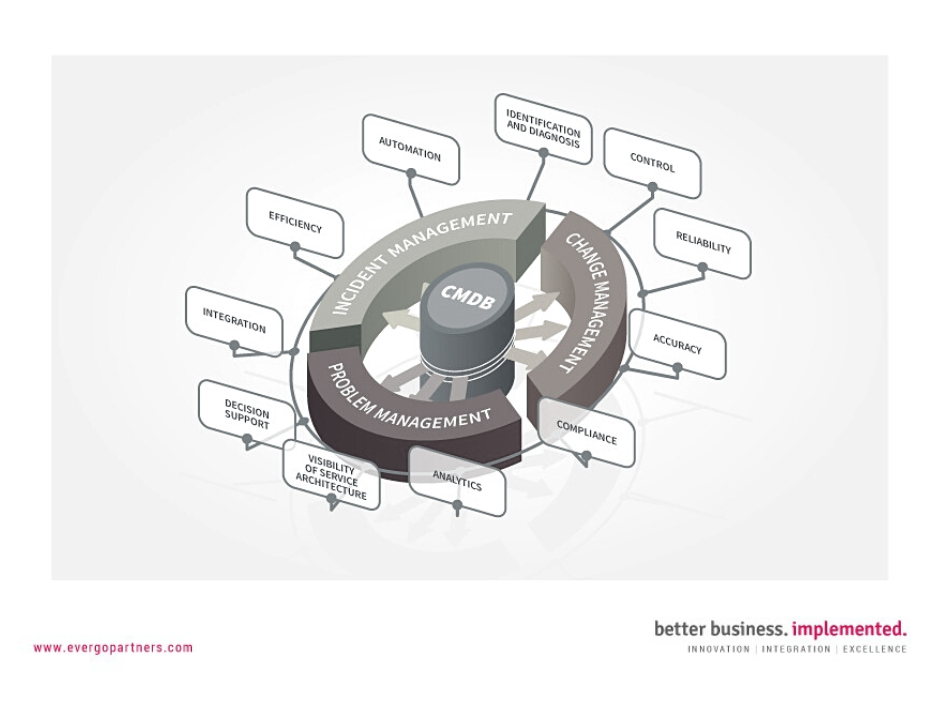Introduction
Let’s start again with some theory by referring to ITIL first.
The Configuration Management System (CMS) and Configuration Management Databases (CMDBs) are the definitions used in the ITIL Service Asset and Configuration Management.
The ITIL defines the Configuration Management System (CMS) as a set of tools and data that is used for collecting, storing, managing, updating, analyzing and presenting data about all configuration items and their relationships. A CMS may manage more than one physical Configuration Management Database (CMDB).
Key components of the CMS/CMDB are:
- Configuration Item (CI) – Any Component that needs to be managed in order to deliver an IT Service. Information about each CI is recorded in a Configuration Record within the Configuration Management System and is maintained throughout its Lifecycle by Configuration Management. CIs typically include IT Services, hardware, software, buildings, people, and formal documentation such as Process documentation and SLAs;
- Attribute – A piece of information about a Configuration Item. Examples are Name, Location, Version Number, and Cost;
- Relationships – logical connections describing dependencies between CIs;
- In other words, CMS/CMDB is a map of IT Services and their components as well as surrounding elements connected in a logical way. But it’s not only a current snapshot but it’s also (or at least should be) a very valuable source of historical data.
There is a long list of potential benefits coming from well implemented CMS/CMDB especially when it comes to managing assets, compliance or regulatory requirements. In some cases, these are sufficient reasons to implement CMDB. However, in this article we would like to share benefits related to Incident, Change, and Problem Management where we (at EvergoPartners) think the real power of relationships between Cis can be utilized in your day to day operations.
Incident Management
According to ITIL the primary objective of Incident Management is to restore the IT service to users as quickly as possible. We think that everybody would agree that time to resolve is of critical importance when it comes to incident resolution. Below you can find some examples of how integration of CMS/CMDB and Incident Management can contribute to fulfillment of the objectives as well as some other benefits.
- It helps to identify impacted service unambiguously . It happens that the customer doesn’t know the exact service name but still is able to provide some details about technical components of the service. Having access to CSM/CMDB and relationships from the component up to the Business Service can speed up the initial phase significantly;
- Once the impacted service is identified correctly, then it’s much easier to find relevant knowledge articles/support scripts that can help to solve the issue;
- In case when intervention of the next level support is required, a correct identification of the service allows to dispatch the ticket to the correct team/support group and hence avoid possible ticket bouncing and wasting of time;
- Well integrated with Incident Management module, the CMS/CMDB can provide information about ongoing incident for the CIs. So, if the Service Desk gets a call about issue for a CI and sees that there is another incident for the same CI or for a CI the CI being reported is dependent on, the Service Desk can establish a correct parent-child relationship and stop wasting time for investigation as the activity is already ongoing;
- In complex situations, when multiple teams and (possibly) suppliers should be involved, the information about impacted service and its relationships with other services and components that can be fetched from CMS/CMDB allows to quickly identify right people or teams needed to investigate and resolve the incident;
- Possibility to understand potential impact on other services but also on customers (if they are CIs) allows for correct prioritization of the incident and proper attention to it right from the start;
- If customers are Configuration Items, the CMS/CMDBs can support proactive communication about ongoing incident to the customers of the service.
Change Management
The primary objective of Change Management is to enable beneficial Changes to be made, with minimum disruption to IT services.
In order to prepare for a change, we need to understand potential impact on the business both direct and indirect. In complex environments, where there are tens or even hundreds of services and thousands if not millions of service components as well as multiple user groups, it is not that easy (if possible at all) to assess impact using only expert knowledge. It’s where the relationships written down in CMDB show the power. Having the relationships established and up to date allows you to perform the impact analysis with just one click.
Just one click and you are able to see how many servers are connected to a router that is subject to a change or how many applications are hosted on a server that is subject to a change. And maybe also which and how many customers may be impacted.
Having customer CIs, you would be able to personalize communication to customers of the service that is a subject to the change. Definitely it’s much better to send out such a personalized communication rather than a communication to all users or to put it in on a page nobody looks at.
Problem Management
CMS/CMDB is very useful if not obligatory for Problem Management as well. It’s again thanks to the ability of CMDB to present dependencies between services and service components. Without visibility of all underlying components of a service for which we are doing root cause analysis we may not be able to focus on a right thing or a real problem. That way, we can lose a lot of money and time, and possibly allow for many new incidents to occur. For example, the real problem can be in the server or network components rather than in the application itself.
Knowing the CIs the service is dependent on we can easily check if there were any incidents, changes or events related to these CIs that can help us to get back on track again very quickly.

At EvergoPartners, we strongly believe that having a well implemented and integrated with other processes CMS/CMDB is a critical factor for successful IT Service Management. Let us know if you want to talk about it.




